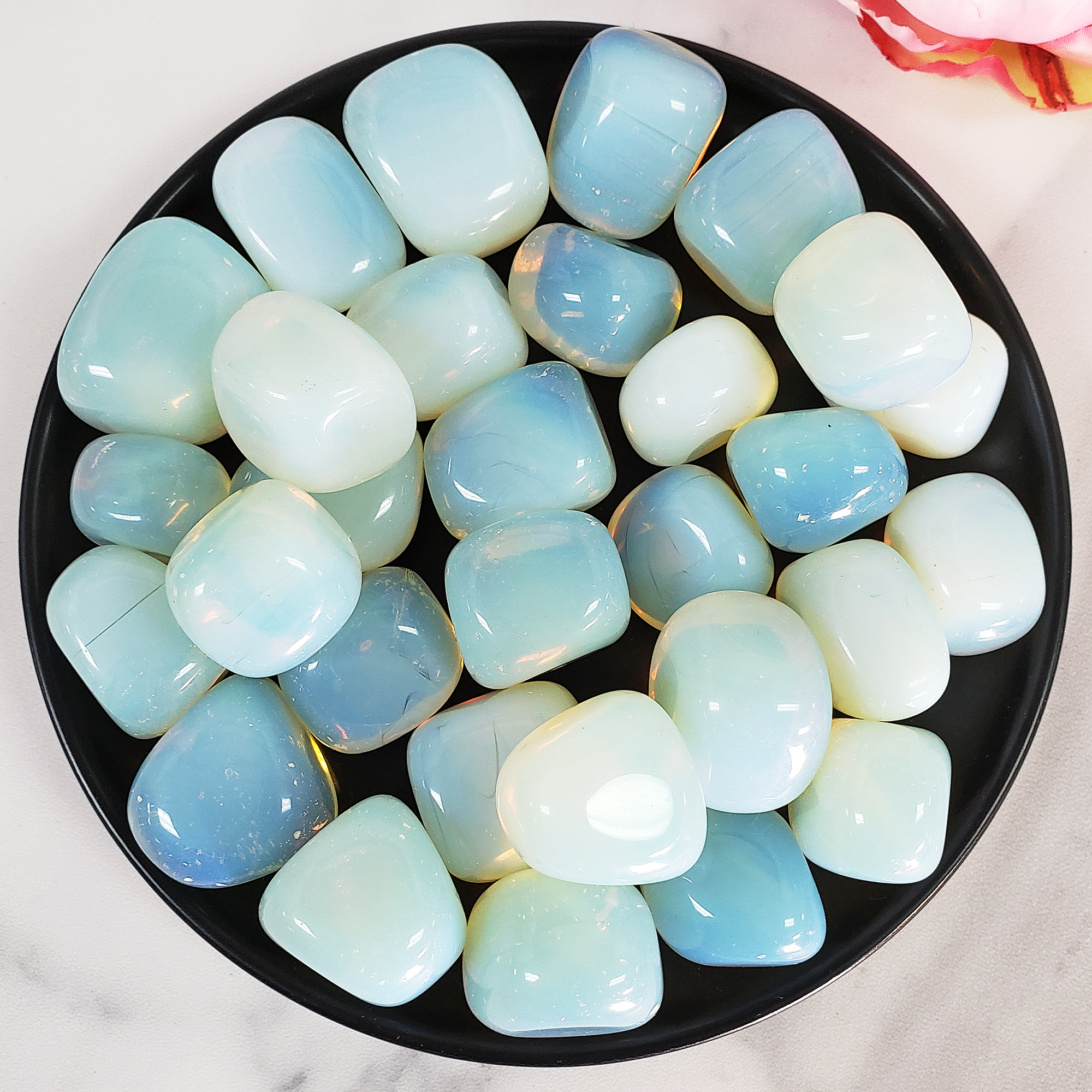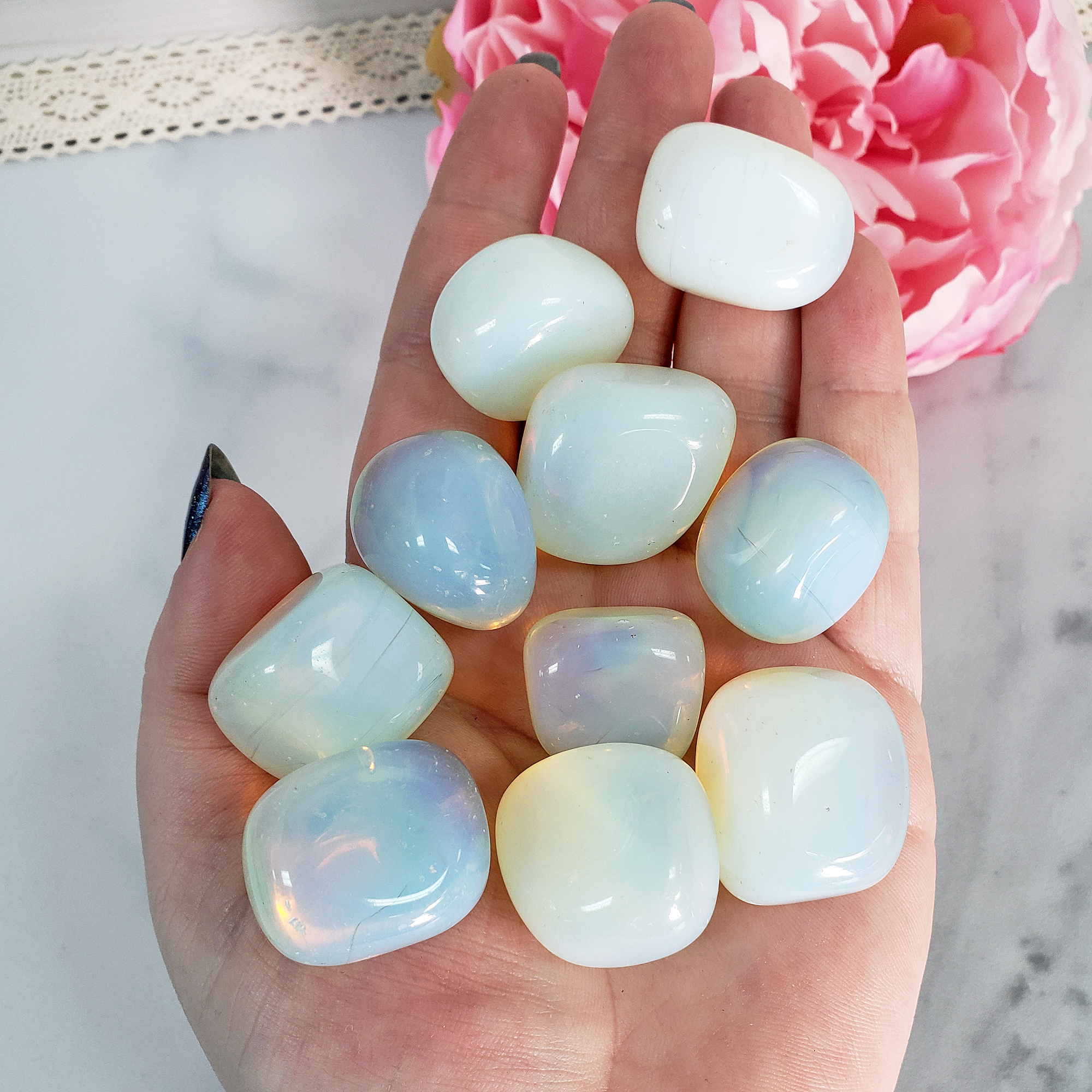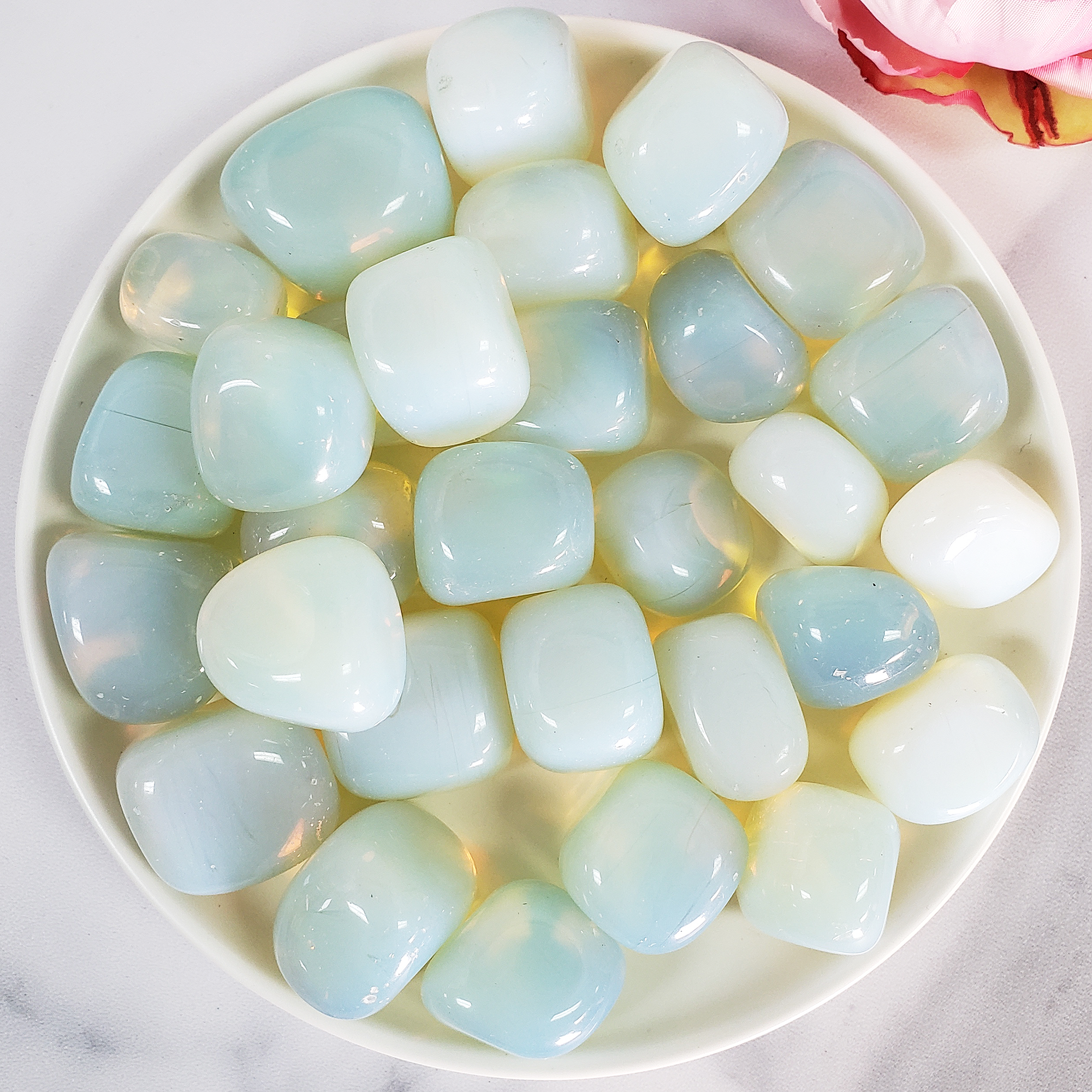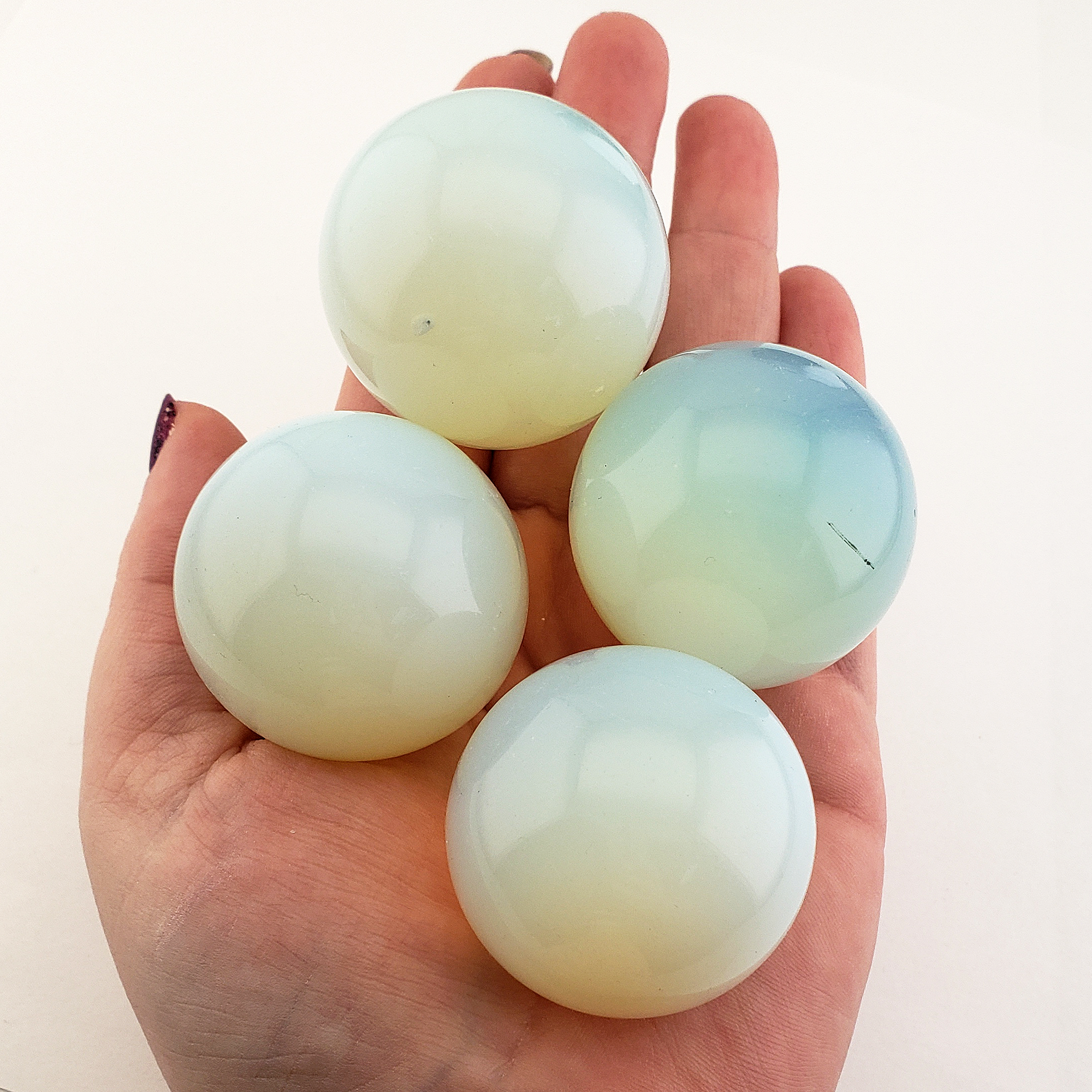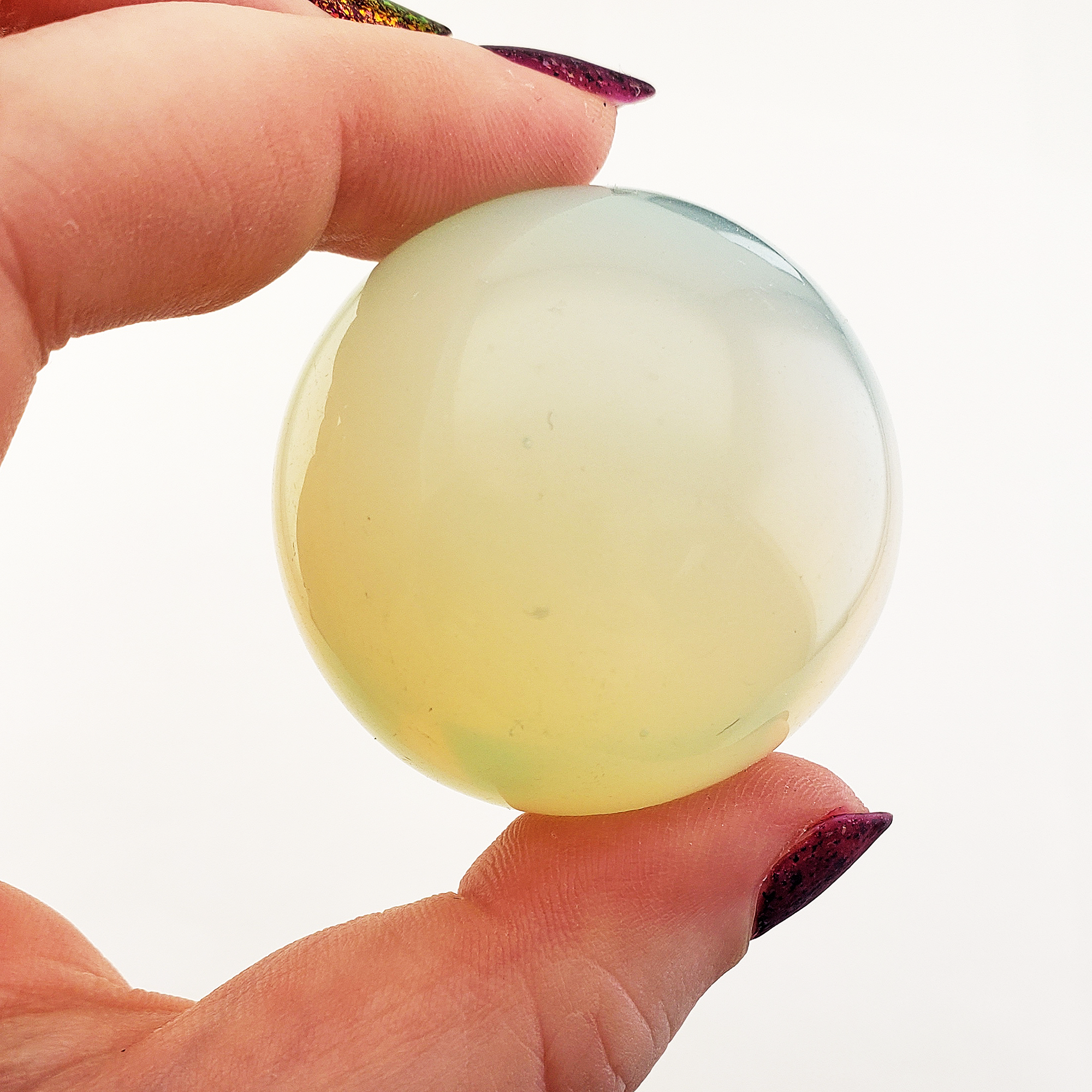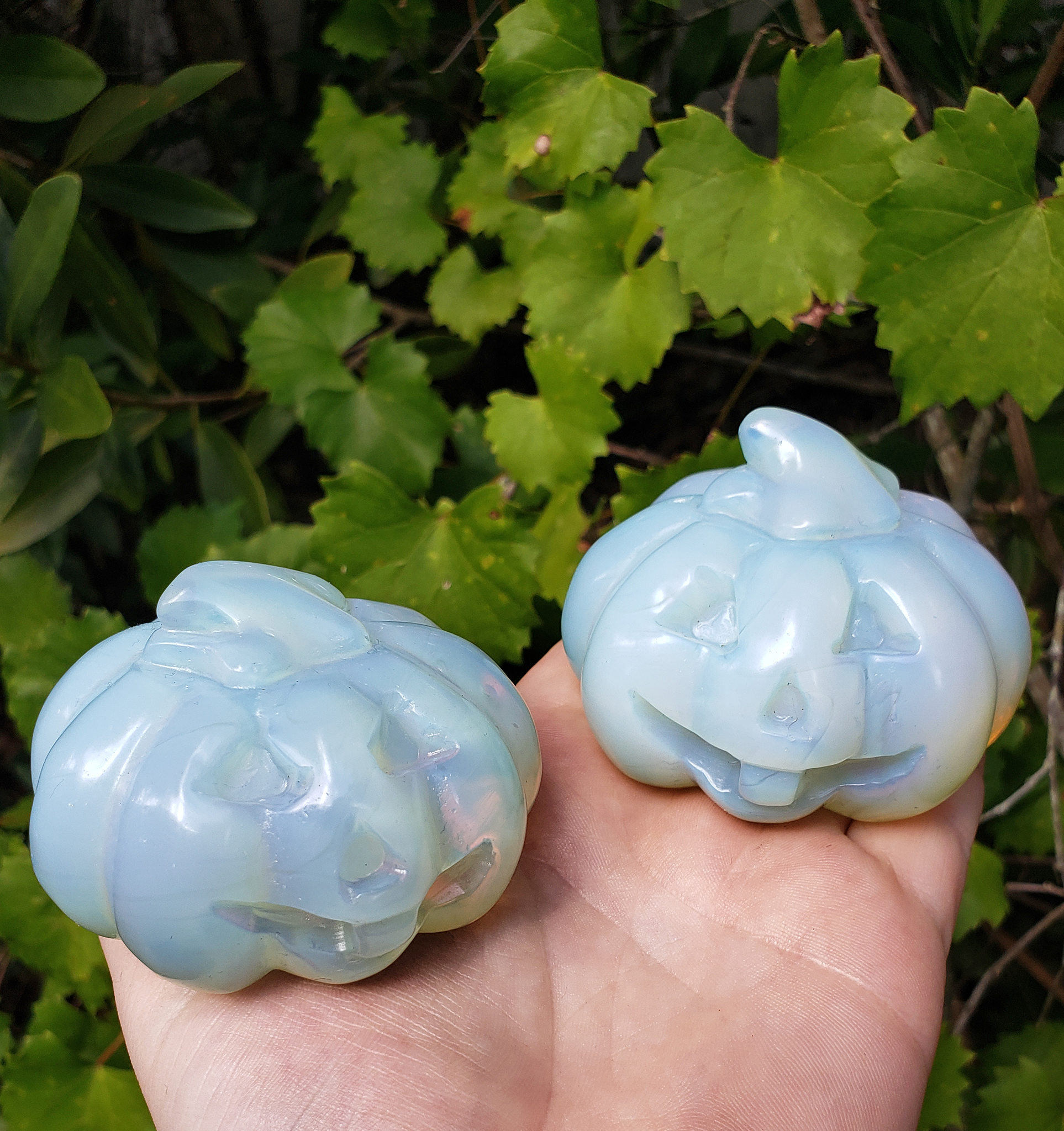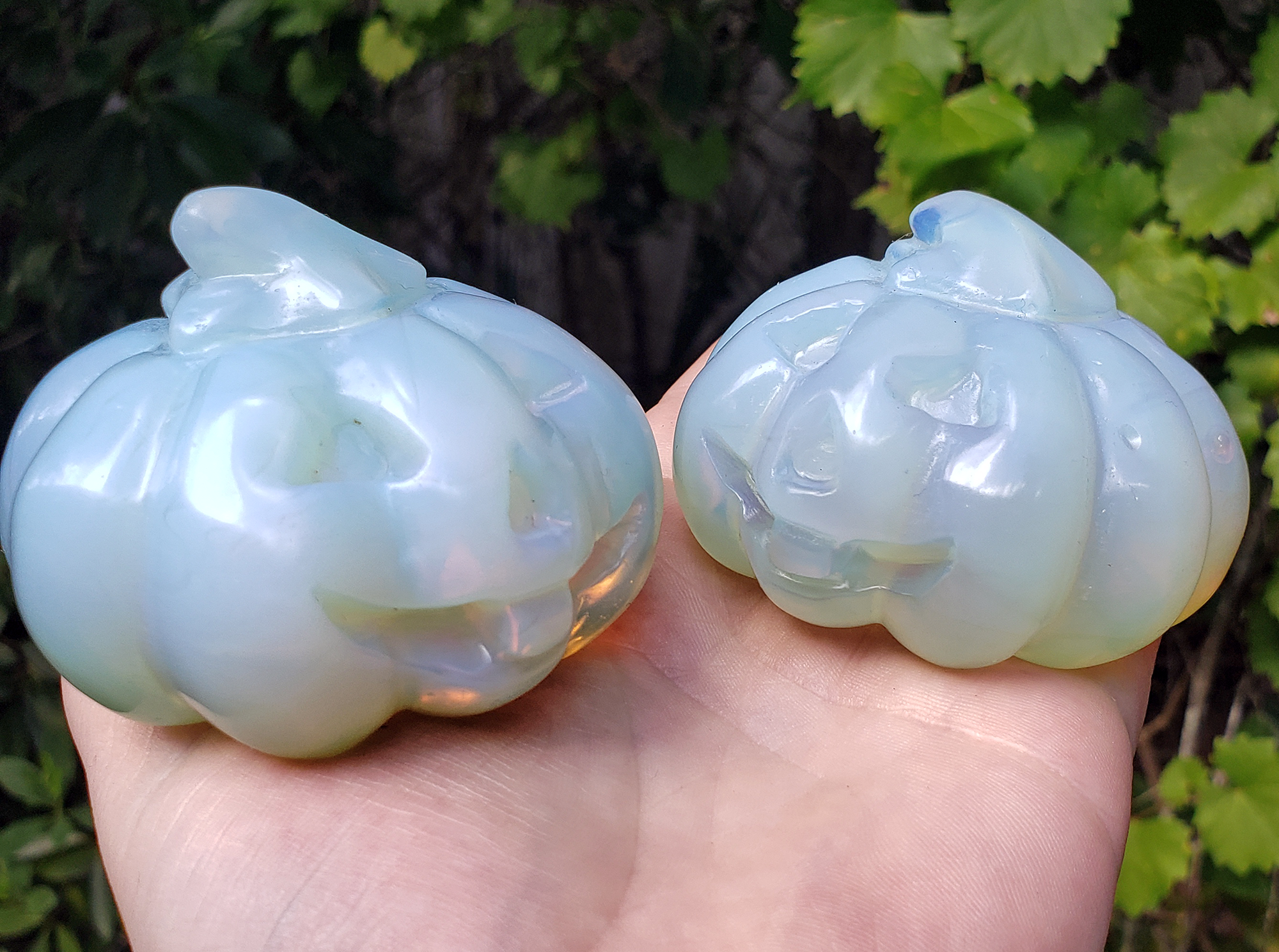What is Opalite Crystal?
We are often asked: Are Opalite and Opal the same thing? Is Opalite manmade? The simple answer is this: Opalite is a manmade gemstone, although its makeup differs slightly depending on the workshop that creates it. Our Opalite crystals, like most, are a type of manmade Obsidian, meaning that they are glass with a proprietary blend of metals and other materials melted together to give it the milky semi-iridescent shine that collectors love. The milky, rainbowy Opalite known by many crystal collectors is not a natural stone that occurs in the depths of the Earth. Rather, it is a product of human creativity and imagination.
Other crystal shops may stock glass Opalite or resin Opalite, and some sources state that they use reconstituted Opal in their Opalite to produce the shine. What this means is that even as a manmade stone, Opalite can vary quite a bit from piece to piece. This results in varying levels of translucency and color, and because Opalite is made of glass or resin, it may feature streaks or bubbles within the material. At times, this makes for an ethereal, fairytale appearance.. and sometimes not so much.
Any crystal shop, whether they are near you or an online store, should always be clear that Opalite is a manmade crystal. Uninformed shops may try to sell Opalite as natural Opal, or even as Moonstone, but remember: Opalite crystals are manmade. Opalite and Opal are not the same, and neither are Opalite and Moonstone. Opal and Moonstone are both natural gems, while this is not the case with Opalite.
Despite this, the milky rainbow beauty of manmade Opalite makes it a highly popular gemstone for decoration, meditation, and crystal jewelry. Opalite crystals are also often incorporated into suncatchers, since it shows off its spellbinding loveliness best when bright light shines through it. As with other manmade gemstones, such as Blue Goldstone, Indigo Obsidian, and others, Opalite is a crystal that many practitioners incorporate into their spiritual work, using it to channel energy and focus intent. Each person's experience and feelings regarding the use of manmade stones differs, so it is important to determine the recipient's preference if you are considering an Opalite crystal as a gift for friends or family.
Is There Natural Opalite?
Are Opalite and Opal the same thing? Is Opalite manmade? The simple answer is this: The rainbow Opalite collectors are familiar with is a manmade gemstone, although its makeup differs slightly depending on the workshop that creates it. Our Opalite crystals, like most, are a type of manmade Obsidian, meaning that they are glass with a proprietary blend of metals and other materials melted together to give it the milky semi-iridescent shine that collectors love.
The milky, rainbowy Opalite known by many crystal collectors is not a natural stone that occurs in the depths of the Earth. Rather, it is a product of human creativity and imagination. Other crystal shops may stock glass Opalite or resin Opalite, and some sources state that they use reconstituted Opal in their Opalite to produce the shine. What this means is that even as a manmade stone, Opalite can vary quite a bit from piece to piece. This results in varying levels of translucency and color, and because Opalite is made of glass or resin, it may feature streaks or bubbles within the material. At times, this makes for an ethereal, fairytale appearance... And sometimes not so much.
All that said, some forms of natural Common Opal (genuine Opal that does not exhibit fire) have been referred to as "Opalite" in the past. This habit is dying out, however, as gem collectors seek to remove any confusion between the manmade material and fireless genuine Opals. Now, most collectors will use the term "Common Opal" when discussing natural Opal without fire, and "Opalite" only when referring to the rainbowy manmade stone.
Opalite Meaning and Metaphysical Properties
Opalite resonates strongly with several Chakras-- Solar Plexus Chakra, Throat Chakra, Third Eye Chakra, and Crown Chakra-- and is known for facilitating many traits that make us more aware of opportunities for growth, prosperity, and happiness. Opalite crystal is often used as a focal stone for manifesting success, since it is associated with self confidence, creativity, forthright communication, awareness, and self empowerment. Opalite's influence is said to be one that helps us to recognize and appreciate our own powers, abilities, and potential, making it easier for us to maintain healthy boundaries and draw the things we want in life toward us. Working with Opalite is an uplifting, encouraging experience, which is why this crystal gem is often chosen for daily use and makes a fantastic focal stone for anyone working in a negative environment.
Understanding the Spiritual Significance of Opalite
Opalite, a gem of enchanting beauty, holds a special place in various cultural and spiritual practices around the world. Beyond its striking appearance, this stone is treasured for its believed metaphysical powers.
Spiritual Connection and Intuition
In many traditions, Opalite is thought to be a stone of transformation. It's often associated with enhanced intuition and a deeper connection to one's inner self. Cultures have long revered it as a bridge to spiritual realms, crediting it with the ability to facilitate communication with spiritual beings and promote inner harmony.
A Tool for Emotional Healing
Opalite's calming energy makes it a sought-after choice for emotional healing. It's believed to help individuals release emotional blockages, and let go of negative vibes. Practitioners use it to foster self-acceptance and confidence, making it a popular addition to meditation and energy healing practices.
Transformation and Renewal
Opalite's role in spiritual and personal transformation cannot be overstated. For centuries, it has been used as a symbol of renewal, aiding individuals on their journeys of personal growth. Its energy is harnessed to balance chakras and promote overall well-being during healing sessions.
Cultural Reverence
The stone's appeal goes beyond aesthetics; its blend of visual allure and spiritual significance captivates jewelry enthusiasts and spiritual seekers alike. Opalite is steeped in cultural history, enriching its allure as both a stunning gemstone and a potent spiritual tool.
In summary, Opalite's cultural significance is woven into its use in spiritual practices, emotional healing, and personal growth. Its rich traditions and applications across various cultures underline its importance as much more than just a visually pleasing stone.
How to Cleanse Opalite
As a manmade stone, Opalite's hardness can vary depending on the materials used to create it. Typically, manmade Opalite is around a 5.5 on the Mohs scale, and is alright for submersion since most varieties of Opalite are made of glass. However, please remember that Opalite can still break or become scratched, so it is important to handle it carefully and avoid dropping or smacking it against other stones. When in doubt, we always suggest charging and cleansing crystals with a Selenite bowl or exposure to Full Moonlight, since these methods will not harm your crystals. Smoke Cleansing with Sage, Palo Santo, Incense, or dried herbs is another safe way to cleanse your Opalite crystal.
Understanding the Market's View on Genuine vs. Synthetic Opalite
The gemstone market holds diverse opinions when it comes to genuine versus synthetic Opalite.
Authenticity and Natural Appeal
For some, the allure of any gem lies in its natural formation and the unique energy associated with it. Collectors and enthusiasts often lean towards genuine stones, valuing their rare origins as part of their spiritual benefits. The appeal here is not just the visual beauty but the connection to the earth and authenticity. For this reason, some collectors choose not to use manmade Opalite in their spiritual practice.
Affordability and Aesthetic of Synthetics
On the other hand, synthetic Opalite enjoys a different kind of popularity. Known for its striking appearance and cost-effectiveness, synthetic options cater to those who appreciate the visual beauty without a hefty price tag. For many, the aesthetic similarity to genuine stones makes synthetic Opalite an attractive choice, especially for fashion-forward individuals who frequently change their accessory styles.
Personal Preference Prevails
Ultimately, the market's perspective hinges on personal preference. Some prioritize the story and rarity of natural Opalite (Common Opal), while others see value in the accessibility and consistent quality of synthetic versions. This dichotomy highlights a broader trend in the gemstone market, with consumers weighing cost, authenticity, and personal beliefs when making their choice.
Tracing the Journey of Opalite Production
Opalite's journey began as a man-made answer to the expensive allure of natural opals. This synthetic gemstone offered the captivating charm of opals without breaking the bank. As time went on, Opalite carved out its niche, securing a vital spot in the jewelry world.
With increasing demand, artisans embarked on a mission to perfect the creation of Opalite. They delved into various glass compositions and additives, searching for the secret to replicating its hypnotic, opalescent glow. This experimentation led to significant technological advancements, as artisans refined their methods.
Today, creating Opalite is an intricate craft. Artisans keenly select high-quality materials to ensure each gemstone boasts the perfect blend of color, translucency, and the magical play of light that Opalite is known for. This evolution in craftsmanship highlights the dedication and skill required to produce such enchanting pieces.
Understanding the History and Origin of Opalite
To fully appreciate Opalite, it's essential to explore its intriguing roots. Opalite doesn't actually originate from natural sources but is a man-made gem crafted through inventive techniques developed in the early s.
Early Beginnings
The story of Opalite starts when artisans began experimenting with methods to mimic the appearance of costly gemstones. These artists, always on the lookout for new materials, stumbled upon glass fusion techniques. By fusing glass with various other substances, they crafted a material that echoed the mesmerizing play of colors found in natural opals.
Evolution of Craftsmanship
Initially conceived as a cost-effective alternative to opals, Opalite quickly gained traction due to its striking, gemstone-like allure. The demand for this luminescent beauty spurred artisans to refine their techniques consistently. Over the decades, they perfected the fusion process, exploring countless glass and additive combinations to enhance the stone's opalescent effects.
Contemporary Production
Today, creating Opalite is an intricate, specialized craft. Skilled artisans meticulously select specific types of glass and additives. This careful selection ensures each Opalite piece exhibits the right balance of color, translucency, and iridescence, encapsulating the essence of genuine opals while remaining accessible.
Thus, the history of Opalite is a testament to human ingenuity. What began as a simple experiment has evolved into a celebrated craft, bringing the enchanting beauty of opals to a broader audience without the associated costs.
Identifying Opalite's Man-Made Nature
Understanding the characteristics of Opalite can help you identify it as a synthetic stone. Here are some key features to look for:
-
Microscopic Composition: When viewed under a microscope, Opalite reveals its artificial origins through a lack of natural inclusions. Unlike genuine opals, which are shaped by the Earth’s geological processes and contain unique inclusions, Opalite displays a flawless and pristine appearance, much like perfectly crafted glass art.
-
Color and Pattern Consistency: Natural stones, such as opals, boast a variety of colors and intricate patterns that tell their own unique stories. In contrast, Opalite is distinguished by its uniform hue and pattern, contributing to its modern and contemporary appeal.
- Gem Tester: We use Presidium gemstone testers in our office, and this is a quick and easy way to distinguish if a stone is authentic or manmade.
By being aware of these characteristics, you can make informed decisions when purchasing gemstones and ensure that you are getting exactly what you expect.
